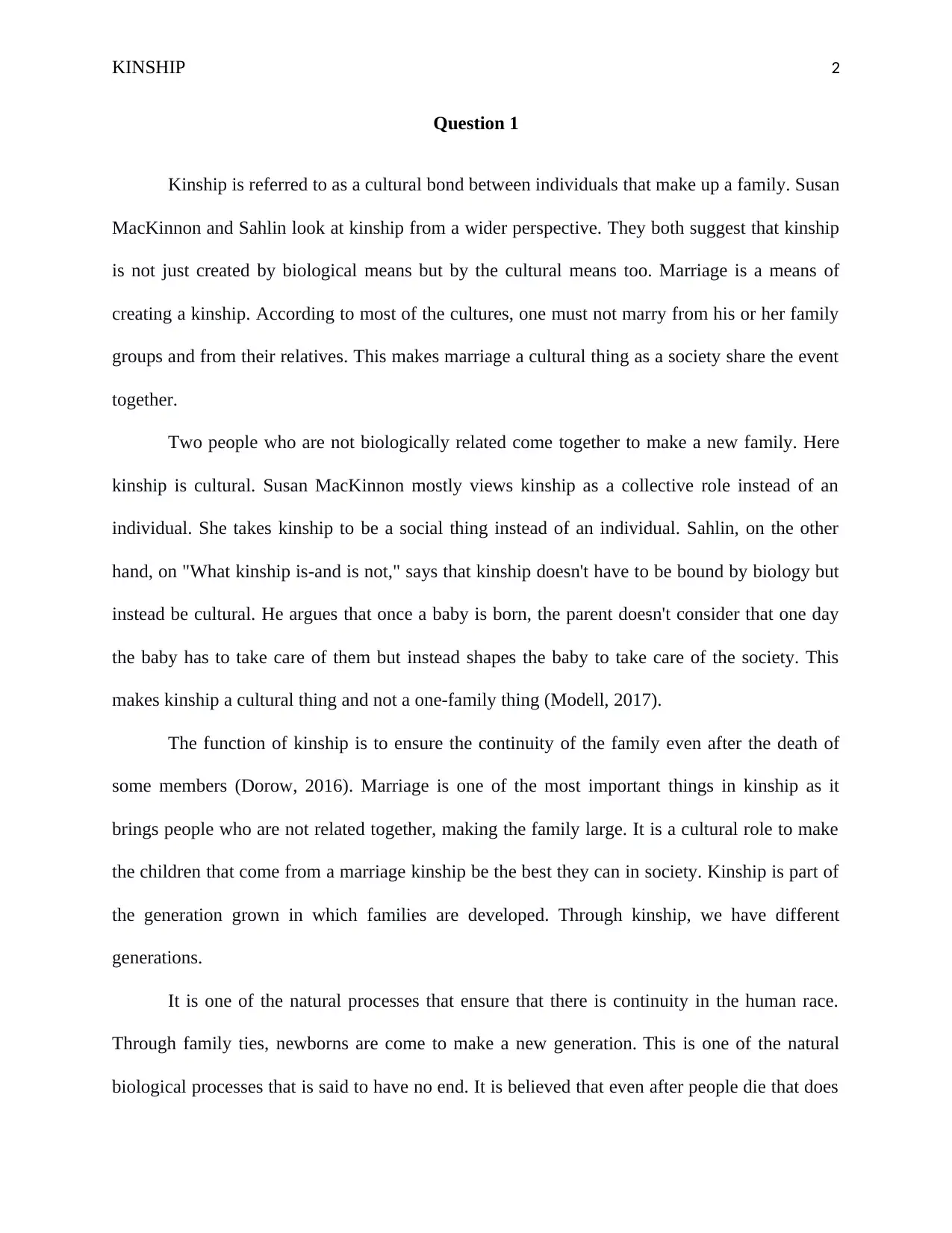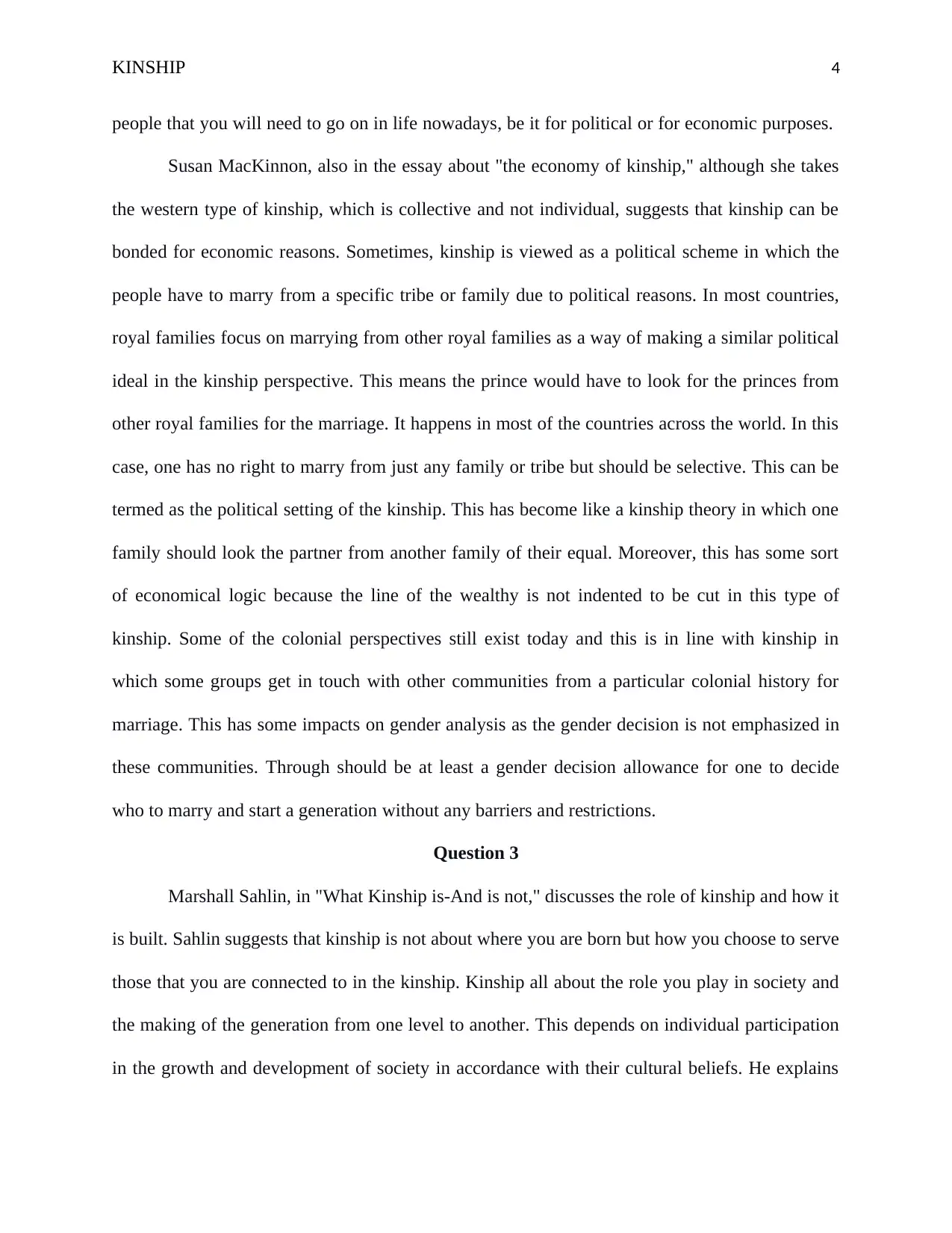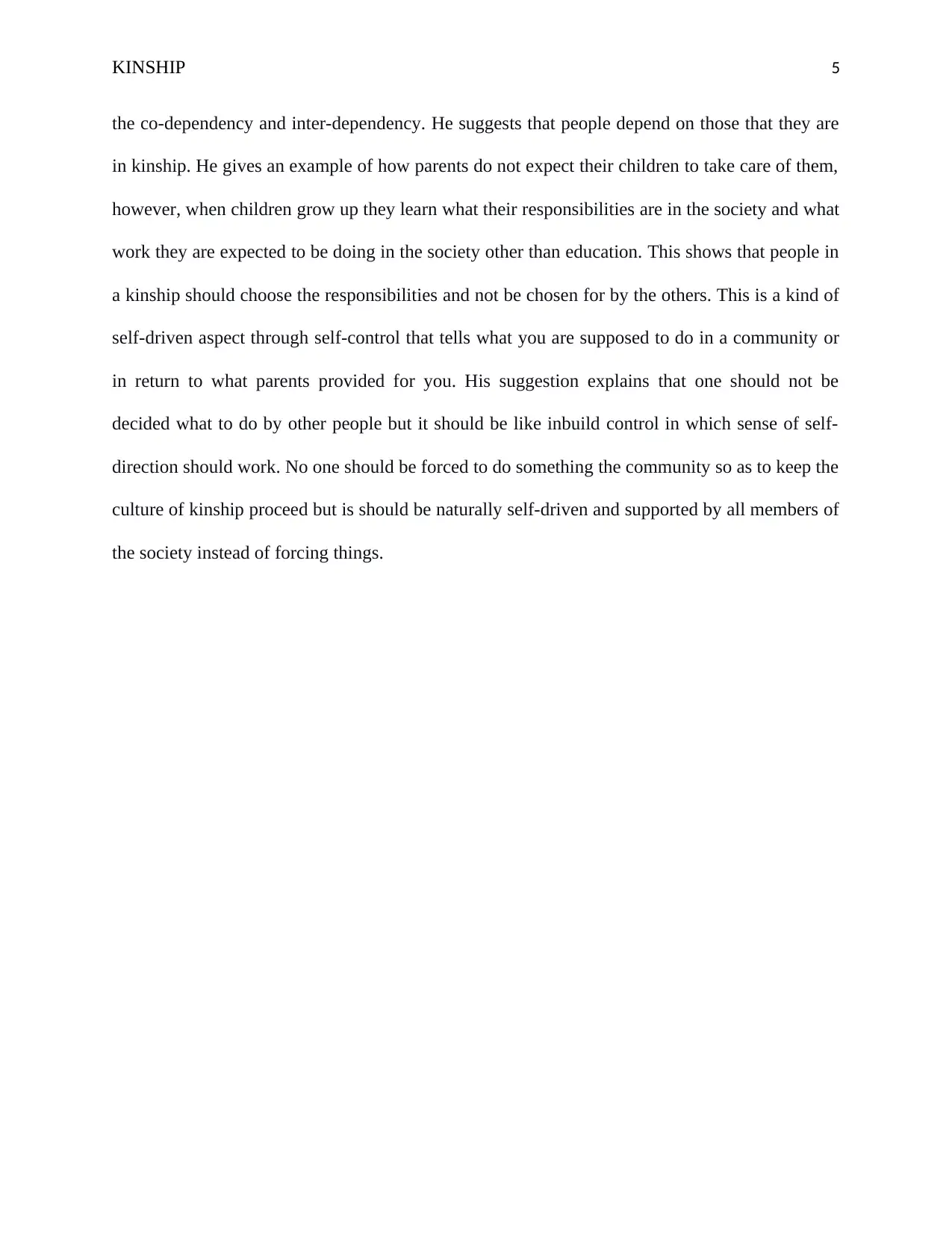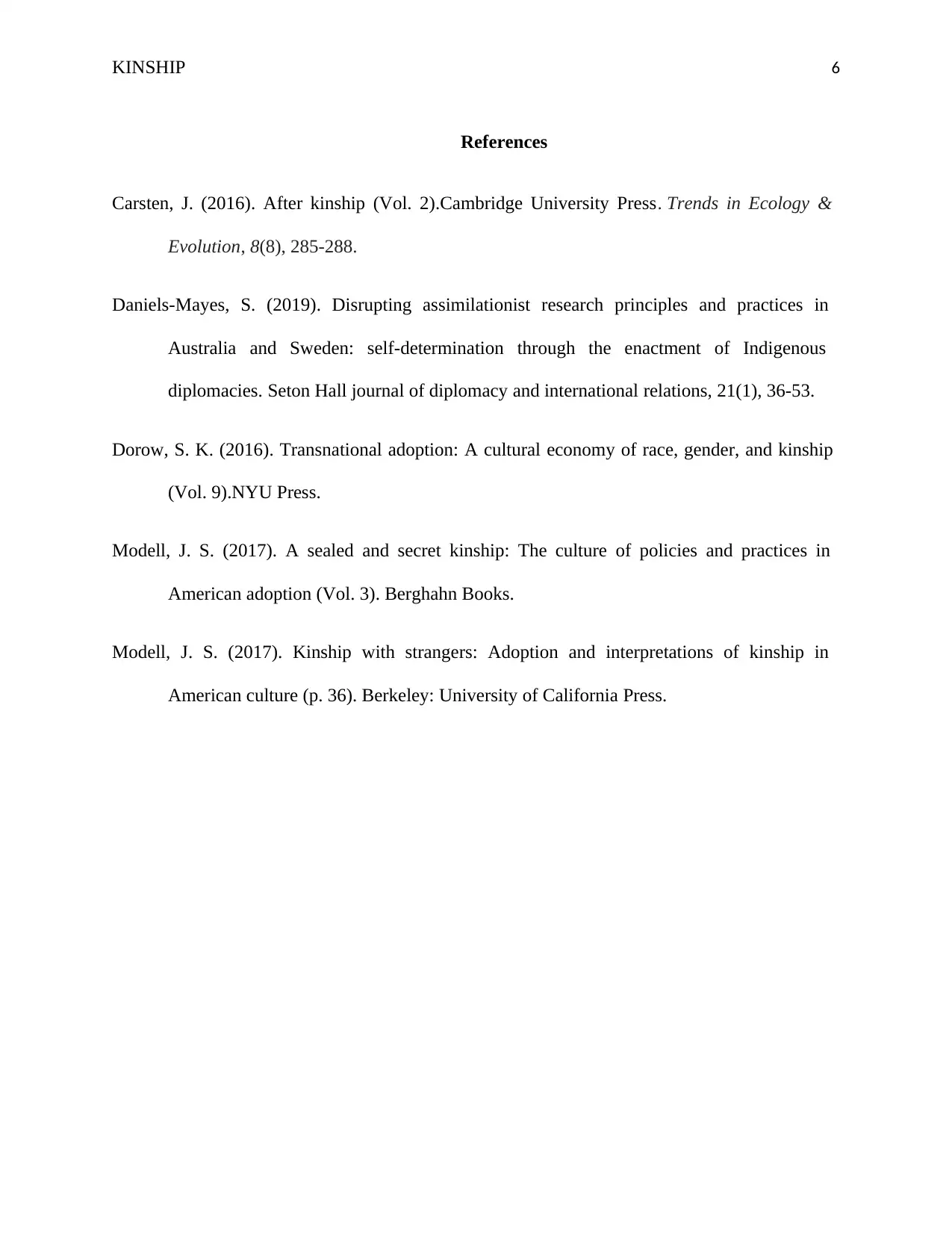Kinship Essay: Analysis of Cultural Bonds, Theories, and Practices
VerifiedAdded on 2022/09/21
|6
|1519
|28
Essay
AI Summary
This essay delves into the multifaceted concept of kinship, examining its cultural underpinnings, social functions, and theoretical perspectives. It explores how kinship, as defined by scholars like Susan McKinnon and Marshall Sahlins, extends beyond biological ties to encompass cultural bonds established through marriage and societal norms. The essay analyzes the role of kinship in maintaining family continuity, shaping generational relationships, and influencing political and economic dynamics. It discusses how kinship systems can be influenced by factors such as economic considerations, political schemes, and colonial perspectives, and the impact these factors have on gender analysis. Furthermore, it examines Sahlin's insights on individual participation and responsibility within kinship structures, emphasizing the importance of self-driven actions and cultural beliefs. The essay integrates perspectives from various scholars to provide a comprehensive understanding of kinship's significance in shaping societies and individual roles within them, offering insights into how kinship is constructed and maintained across different cultures and contexts.

Running head: KINSHIP 1
Kinship
Name
Institution
Professor
Course
Date
Kinship
Name
Institution
Professor
Course
Date
Paraphrase This Document
Need a fresh take? Get an instant paraphrase of this document with our AI Paraphraser

KINSHIP 2
Question 1
Kinship is referred to as a cultural bond between individuals that make up a family. Susan
MacKinnon and Sahlin look at kinship from a wider perspective. They both suggest that kinship
is not just created by biological means but by the cultural means too. Marriage is a means of
creating a kinship. According to most of the cultures, one must not marry from his or her family
groups and from their relatives. This makes marriage a cultural thing as a society share the event
together.
Two people who are not biologically related come together to make a new family. Here
kinship is cultural. Susan MacKinnon mostly views kinship as a collective role instead of an
individual. She takes kinship to be a social thing instead of an individual. Sahlin, on the other
hand, on "What kinship is-and is not," says that kinship doesn't have to be bound by biology but
instead be cultural. He argues that once a baby is born, the parent doesn't consider that one day
the baby has to take care of them but instead shapes the baby to take care of the society. This
makes kinship a cultural thing and not a one-family thing (Modell, 2017).
The function of kinship is to ensure the continuity of the family even after the death of
some members (Dorow, 2016). Marriage is one of the most important things in kinship as it
brings people who are not related together, making the family large. It is a cultural role to make
the children that come from a marriage kinship be the best they can in society. Kinship is part of
the generation grown in which families are developed. Through kinship, we have different
generations.
It is one of the natural processes that ensure that there is continuity in the human race.
Through family ties, newborns are come to make a new generation. This is one of the natural
biological processes that is said to have no end. It is believed that even after people die that does
Question 1
Kinship is referred to as a cultural bond between individuals that make up a family. Susan
MacKinnon and Sahlin look at kinship from a wider perspective. They both suggest that kinship
is not just created by biological means but by the cultural means too. Marriage is a means of
creating a kinship. According to most of the cultures, one must not marry from his or her family
groups and from their relatives. This makes marriage a cultural thing as a society share the event
together.
Two people who are not biologically related come together to make a new family. Here
kinship is cultural. Susan MacKinnon mostly views kinship as a collective role instead of an
individual. She takes kinship to be a social thing instead of an individual. Sahlin, on the other
hand, on "What kinship is-and is not," says that kinship doesn't have to be bound by biology but
instead be cultural. He argues that once a baby is born, the parent doesn't consider that one day
the baby has to take care of them but instead shapes the baby to take care of the society. This
makes kinship a cultural thing and not a one-family thing (Modell, 2017).
The function of kinship is to ensure the continuity of the family even after the death of
some members (Dorow, 2016). Marriage is one of the most important things in kinship as it
brings people who are not related together, making the family large. It is a cultural role to make
the children that come from a marriage kinship be the best they can in society. Kinship is part of
the generation grown in which families are developed. Through kinship, we have different
generations.
It is one of the natural processes that ensure that there is continuity in the human race.
Through family ties, newborns are come to make a new generation. This is one of the natural
biological processes that is said to have no end. It is believed that even after people die that does

KINSHIP 3
not make the end of the kinship. It is transportation from one generation to another. They join the
living dead generation and that is why it is referred to as a continuous biological process. It starts
from the lower level when people come together for marriage to make the children and the
children proceed with the generation.
It must start with the people who are not biologically related. This is because if people of
the same biological relationship get intermarried, this is referred to as the taboo to many of the
communities across the work and it is not acceptable in any community. This can not be termed
as the kinship start because it is not allowed in the community setting to avoid the issue of
inbreeding. Therefore, kinship starts when people of different biological relations come together
and marries one another starting a family. This societal rule of marrying from a different group is
what makes this kinship to be a cultural norm.
Question 2
Kinship is bound that is made either by biology or by choice. People do not have to share
generic for them to share kinship (Carsten, 2016). During the old days, people used marriage
kinship to forge political bonds between kingdoms. This ensured that the two kingdoms that
bonded by kinship will never fight against each other and will support each other when wartime
came. This was done by marrying royal children from one kingdom with royal children from
another kingdom. The married couple knew their role in society (Daniels-Mayes, 2019). People
also married for economic reasons. A father would marry his female children so that he would
get money or dowry in other forms to support the rest of the family. David Schneider in the book
“American Kinship," looks at kinship from a different perspective and not the normal family
relationship. He looks at it in the view of substance vs. code. This reflects that kinship can be
viewed as a source of help when needed (Modell, 2017). You can create a kinship from the
not make the end of the kinship. It is transportation from one generation to another. They join the
living dead generation and that is why it is referred to as a continuous biological process. It starts
from the lower level when people come together for marriage to make the children and the
children proceed with the generation.
It must start with the people who are not biologically related. This is because if people of
the same biological relationship get intermarried, this is referred to as the taboo to many of the
communities across the work and it is not acceptable in any community. This can not be termed
as the kinship start because it is not allowed in the community setting to avoid the issue of
inbreeding. Therefore, kinship starts when people of different biological relations come together
and marries one another starting a family. This societal rule of marrying from a different group is
what makes this kinship to be a cultural norm.
Question 2
Kinship is bound that is made either by biology or by choice. People do not have to share
generic for them to share kinship (Carsten, 2016). During the old days, people used marriage
kinship to forge political bonds between kingdoms. This ensured that the two kingdoms that
bonded by kinship will never fight against each other and will support each other when wartime
came. This was done by marrying royal children from one kingdom with royal children from
another kingdom. The married couple knew their role in society (Daniels-Mayes, 2019). People
also married for economic reasons. A father would marry his female children so that he would
get money or dowry in other forms to support the rest of the family. David Schneider in the book
“American Kinship," looks at kinship from a different perspective and not the normal family
relationship. He looks at it in the view of substance vs. code. This reflects that kinship can be
viewed as a source of help when needed (Modell, 2017). You can create a kinship from the
⊘ This is a preview!⊘
Do you want full access?
Subscribe today to unlock all pages.

Trusted by 1+ million students worldwide

KINSHIP 4
people that you will need to go on in life nowadays, be it for political or for economic purposes.
Susan MacKinnon, also in the essay about "the economy of kinship," although she takes
the western type of kinship, which is collective and not individual, suggests that kinship can be
bonded for economic reasons. Sometimes, kinship is viewed as a political scheme in which the
people have to marry from a specific tribe or family due to political reasons. In most countries,
royal families focus on marrying from other royal families as a way of making a similar political
ideal in the kinship perspective. This means the prince would have to look for the princes from
other royal families for the marriage. It happens in most of the countries across the world. In this
case, one has no right to marry from just any family or tribe but should be selective. This can be
termed as the political setting of the kinship. This has become like a kinship theory in which one
family should look the partner from another family of their equal. Moreover, this has some sort
of economical logic because the line of the wealthy is not indented to be cut in this type of
kinship. Some of the colonial perspectives still exist today and this is in line with kinship in
which some groups get in touch with other communities from a particular colonial history for
marriage. This has some impacts on gender analysis as the gender decision is not emphasized in
these communities. Through should be at least a gender decision allowance for one to decide
who to marry and start a generation without any barriers and restrictions.
Question 3
Marshall Sahlin, in "What Kinship is-And is not," discusses the role of kinship and how it
is built. Sahlin suggests that kinship is not about where you are born but how you choose to serve
those that you are connected to in the kinship. Kinship all about the role you play in society and
the making of the generation from one level to another. This depends on individual participation
in the growth and development of society in accordance with their cultural beliefs. He explains
people that you will need to go on in life nowadays, be it for political or for economic purposes.
Susan MacKinnon, also in the essay about "the economy of kinship," although she takes
the western type of kinship, which is collective and not individual, suggests that kinship can be
bonded for economic reasons. Sometimes, kinship is viewed as a political scheme in which the
people have to marry from a specific tribe or family due to political reasons. In most countries,
royal families focus on marrying from other royal families as a way of making a similar political
ideal in the kinship perspective. This means the prince would have to look for the princes from
other royal families for the marriage. It happens in most of the countries across the world. In this
case, one has no right to marry from just any family or tribe but should be selective. This can be
termed as the political setting of the kinship. This has become like a kinship theory in which one
family should look the partner from another family of their equal. Moreover, this has some sort
of economical logic because the line of the wealthy is not indented to be cut in this type of
kinship. Some of the colonial perspectives still exist today and this is in line with kinship in
which some groups get in touch with other communities from a particular colonial history for
marriage. This has some impacts on gender analysis as the gender decision is not emphasized in
these communities. Through should be at least a gender decision allowance for one to decide
who to marry and start a generation without any barriers and restrictions.
Question 3
Marshall Sahlin, in "What Kinship is-And is not," discusses the role of kinship and how it
is built. Sahlin suggests that kinship is not about where you are born but how you choose to serve
those that you are connected to in the kinship. Kinship all about the role you play in society and
the making of the generation from one level to another. This depends on individual participation
in the growth and development of society in accordance with their cultural beliefs. He explains
Paraphrase This Document
Need a fresh take? Get an instant paraphrase of this document with our AI Paraphraser

KINSHIP 5
the co-dependency and inter-dependency. He suggests that people depend on those that they are
in kinship. He gives an example of how parents do not expect their children to take care of them,
however, when children grow up they learn what their responsibilities are in the society and what
work they are expected to be doing in the society other than education. This shows that people in
a kinship should choose the responsibilities and not be chosen for by the others. This is a kind of
self-driven aspect through self-control that tells what you are supposed to do in a community or
in return to what parents provided for you. His suggestion explains that one should not be
decided what to do by other people but it should be like inbuild control in which sense of self-
direction should work. No one should be forced to do something the community so as to keep the
culture of kinship proceed but is should be naturally self-driven and supported by all members of
the society instead of forcing things.
the co-dependency and inter-dependency. He suggests that people depend on those that they are
in kinship. He gives an example of how parents do not expect their children to take care of them,
however, when children grow up they learn what their responsibilities are in the society and what
work they are expected to be doing in the society other than education. This shows that people in
a kinship should choose the responsibilities and not be chosen for by the others. This is a kind of
self-driven aspect through self-control that tells what you are supposed to do in a community or
in return to what parents provided for you. His suggestion explains that one should not be
decided what to do by other people but it should be like inbuild control in which sense of self-
direction should work. No one should be forced to do something the community so as to keep the
culture of kinship proceed but is should be naturally self-driven and supported by all members of
the society instead of forcing things.

KINSHIP 6
References
Carsten, J. (2016). After kinship (Vol. 2).Cambridge University Press. Trends in Ecology &
Evolution, 8(8), 285-288.
Daniels-Mayes, S. (2019). Disrupting assimilationist research principles and practices in
Australia and Sweden: self-determination through the enactment of Indigenous
diplomacies. Seton Hall journal of diplomacy and international relations, 21(1), 36-53.
Dorow, S. K. (2016). Transnational adoption: A cultural economy of race, gender, and kinship
(Vol. 9).NYU Press.
Modell, J. S. (2017). A sealed and secret kinship: The culture of policies and practices in
American adoption (Vol. 3). Berghahn Books.
Modell, J. S. (2017). Kinship with strangers: Adoption and interpretations of kinship in
American culture (p. 36). Berkeley: University of California Press.
References
Carsten, J. (2016). After kinship (Vol. 2).Cambridge University Press. Trends in Ecology &
Evolution, 8(8), 285-288.
Daniels-Mayes, S. (2019). Disrupting assimilationist research principles and practices in
Australia and Sweden: self-determination through the enactment of Indigenous
diplomacies. Seton Hall journal of diplomacy and international relations, 21(1), 36-53.
Dorow, S. K. (2016). Transnational adoption: A cultural economy of race, gender, and kinship
(Vol. 9).NYU Press.
Modell, J. S. (2017). A sealed and secret kinship: The culture of policies and practices in
American adoption (Vol. 3). Berghahn Books.
Modell, J. S. (2017). Kinship with strangers: Adoption and interpretations of kinship in
American culture (p. 36). Berkeley: University of California Press.
⊘ This is a preview!⊘
Do you want full access?
Subscribe today to unlock all pages.

Trusted by 1+ million students worldwide
1 out of 6
Related Documents
Your All-in-One AI-Powered Toolkit for Academic Success.
+13062052269
info@desklib.com
Available 24*7 on WhatsApp / Email
![[object Object]](/_next/static/media/star-bottom.7253800d.svg)
Unlock your academic potential
Copyright © 2020–2025 A2Z Services. All Rights Reserved. Developed and managed by ZUCOL.





